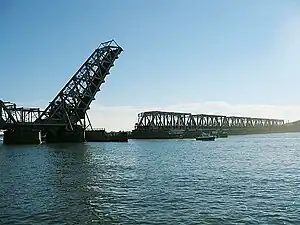Amtrak Old Saybrook–Old Lyme Bridge
The Amtrak Old Saybrook–Old Lyme Bridge[lower-alpha 1] is the last crossing of the Connecticut River before it reaches Long Island Sound. It is a Truss bridge with a bascule span, allowing boat traffic to pass through. The bridge is owned by Amtrak and used by Northeast Regional, Acela Express, Shore Line East and a few freight trains traversing the Northeast Corridor. It can be seen from the Raymond E. Baldwin Bridge (Interstate 95 and U.S. Route 1), as well as from various points on Route 154.
Amtrak Old Saybrook–Old Lyme Bridge | |
|---|---|
 A view of the bridge in the open position on August 5, 2007. | |
| Coordinates | 41.3108°N 72.3492°W |
| Carries | Two railroad tracks with overhead lines (Northeast Corridor) |
| Crosses | Connecticut River |
| Locale | Old Saybrook and Old Lyme, Connecticut |
| Owner | Amtrak |
| Characteristics | |
| Design | Baltimore truss bridge with a bascule span |
| Material | Steel |
| Total length | 1,659.6 feet (505.8 m)[1] |
| Longest span | 161 feet (49 m)[1] |
| No. of spans | 9 fixed + 1 bascule[1] |
| Clearance below | 18 feet (5.5 m) (closed) 68 feet (21 m) (open)[2] |
| History | |
| Designer | Scherzer Rolling Lift Bridge Company, Chicago[1] |
| Construction end | 1907 |
| Statistics | |
| Daily traffic | 56 daily trains:[2] 38 Amtrak intercity trains 12 Shore Line East commuter trains 6 P&W freight trains |
| Location | |
History

Also known as the Connecticut River Railroad Bridge and Connecticut River Bridge, it was built in 1907 by the Scherzer Rolling Lift Bridge Company of Chicago, for the New York, New Haven and Hartford Railroad. It replaced an earlier bridge, which was built in 1870 and rebuilt on the same piers in 1889.[3][4] The old single-track bridge was no longer able to handle the train frequency and weights that the New Haven wished to run. Construction of the new bridge began in May 1905, and the substructure was completed in April 1906. The bridge was built with two-track spans, with the abutments long enough for a second set of spans should quadruple-tracking of the line take place.[5] The new bridge opened on August 6, 1907.[3]
The bridge underwent a structural rehabilitation in 1976, and had mechanical and electrical rehabilitation in 1981 and 1997. In 2000 the bridge experienced a major electrical failure which rendered the drawspan stuck in the open position (blocking railroad traffic).[1] The bridge became stuck in the closed position twice in 2001.[6] A 2006 inspection found the bridge to be structurally deficient and determined that periodic rehabilitation work was no longer sufficient to keep the century-old bridge functional.[2] The bridge was determined to be eligible for listing on the National Register of Historic Places in 1987, but it was not finally listed due to owner objection.[7][8]
Replacement
The structurally deficient bridge is planned for replacement. An Environmental Assessment released in May 2014 identified two preferred alternatives: a bascule bridge similar in size to the existing span, or a vertical lift bridge with possibly increased clearances. Either option would be built on a parallel alignment just south of the existing bridge. Fully high-level designs without movable sections were eliminated from consideration due to the massive approaches that would have to be built, which would have major impacts on nearby wetlands and increase construction and land acquisition costs.[2] Construction staging plans were released in April 2020. Those plans call for a replacement bascule bridge 52 feet (16 m) south of the existing span, with clearance in the closed position increased from 18 feet (5.5 m) to 24 feet (7.3 m).[9] Amtrak and ConnDOT were awarded $65.2 million in federal funds for the replacement in October 2020.[10]
As of October 2022, Amtrak plans to begin the procurement process in early 2023 and award the construction contract later that year. Construction would begin in early 2024.[11] In mid-2023, Amtrak applied for a federal grant to replace the bridge.[12]
Notes
- May be simplified as either Old Saybrook Bridge or Old Lyme Bridge, sans Amtrak.
References
- O'Neill, Jr., Paul X.; Ostrovsky, Alex (October 22, 2002). "Failure and Quick Recovery of Movable Bridge on the Acela Line" (PDF).
- "Connecticut River Bridge Replacement Project: Environmental Assessment & Section 4(f) Evaluation". Federal Railroad Administration. May 28, 2014. Retrieved April 14, 2016.
- Levy, Tedd (September 24, 2012). "LOCAL HISTORY: Looking back at the Conn River RR bridge, over 100 years". CT Insider. Retrieved November 1, 2022.
- Karr, Ronald Dale (1995). The Rail Lines of Southern New England. Branch Line Press. p. 95. ISBN 0942147022.
- Soehrens, J.H. (1907). "The New Connecticut River Bridge". Papers and Transactions for 1906 and Proceedings of the Twenty-Third Annual Meeting. Connecticut Society of Civil Engineers: 87–95.
- Overton, Penelope (August 24, 2001). "Aging Bridge Causes Delays". Hartford Courant.
- "National Register Information System – (#87002125)". National Register of Historic Places. National Park Service. March 13, 2009.
- Bruce Clouette, Matthew Roth and John Herzan (February 4, 1986). "Movable Railroad Bridges on the NE Corridor in Connecticut TR". National Park Service. National Register of Historic Places Inventory-Nomination Form.
- Hewitt, Cate (May 14, 2020). "$400 Million Connecticut River Railroad Bridge Replacement Takes a Step Forward, Design Details Announced". Connecticut Examiner.
- "USDOT awards rail-repair grants for projects in Connecticut, NJ, California". Progressive Railroading. October 28, 2020.
- "Amtrak Begins Procurement for Construction of New Connecticut River Bridge" (Press release). Amtrak. October 28, 2022.
- "Amtrak Applies for $7.3 Billion in Federal Grants to Advance Northeast Corridor Infrastructure Upgrades" (Press release). Amtrak. June 5, 2023.